Interview prep
How to write a compelling resume
by Kai Davis
Resumes are a necessary exercise during your job search. Writing one helps you understand how to position your experience and qualifications in the job interview.
It’s a minority of people that get a job solely off of a resume. If you’re approaching your job search strategically (setting up coffee meetings, researching the companies you want to work at, building and maintaining a personal network, etc), you can be hired without ever sending in a resume.
The biggest value in writing a resume is gaining an understanding of the specific problems the company is facing and how to position your experience and qualifications to solve those problems.
Two years ago, when I was hiring to build out my marketing department, I read through dozens of resumes and cover letters. The biggest problem that kept me from selecting a candidate for an interview? They didn’t include any information that connected their resume with the position I was hiring for.
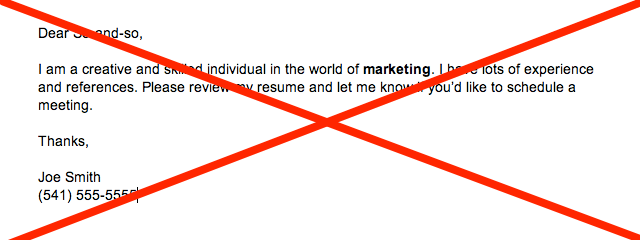
As a guy who has sat on both sides of the hiring table (hiring employees for a department, hiring freelancers for a small business, interviewing for positions, etc), let me tell you, the easiest way to have your resume shoot you in the foot is to have a disconnect between the position you’re applying for and the experience and story you share on your resume.
It doesn’t matter how qualified you are. Unless you can show how your experience and qualifications directly relate to the position you’re applying for and help your employer solve problems, earn more money, and reduce costs, it’s pointless to even apply.
The best way to get an interview (aside from networking, building and maintaining a network, etc), is to highlight the direct connection between your experience, your qualifications, and the needs highlighted in the job description you’re applying to fill.
So, let’s tackle how we’ll do this. In this article, we’ll dive into how to write a resume:
- We’ll review an actual position description off of Craigslist and follow my system for isolating painful problems / specific needs
- I’ll share my system for quickly analyzing a job posting in ~10-minute to identify specific needs, keywords, and qualifications
- We’ll review the resume writing template I use when writing resumes
- I’ll explain the ‘1–2–3’ process I use to expand on experience and buzzwords to build a rich, content-heavy resume
- I’ll show you why the best change you can make is taking credit for your accomplishments
Finding the employer’s pain points
When applying for a job, I want to show the employer:
- How my experience and qualifications align with the needs of the position
- My deep understanding of who they’re looking for
- How I’ll help them increase their revenue, decrease their costs, and eliminate painful problems
How do we do that? By performing a close reading of the position description and following a quick + simple exercise to break out the exact keywords and key phrases they use to describe the problems they’re facing.
My theory? Companies only hire new employees when the lack of another employee has become so painful, the employer will do almost anything to eliminate the pain.
Employees cost money. Lots of money. If there isn’t an immediate and painful need to hire a new employee, why spend the money?
Because employers only hire when they’re experiencing a pain, you can identify exactly what pain the employer is experiencing by performing a close reading of the position description. Specifically, we’re going to:
- Walk through the process I use to review a position description
- Break down the exact steps to go through to identify the pain points a company is screaming about in the position description
- Review how to analyze position descriptions to pull out specific needs and make a list of the exact language the employer uses to talk about their pain (the specific keywords and key phrases that need to be repeated in your resume and cover letter).
Here’s the position description we’ll be working off of: Merchandising Manager — Honolulu Cookie Company
My process for reviewing a position description
My first step is to read through the position description and look for red flags. Is it an unpaid position? Commission only? Does the company seem like one I’d like to work for (I’ll load their website to check this out)?
If the position passes that test, I’ll print out a copy of the position description to closely read through and mark up. (I like underlining phrases in the description and making notes in the margin).
Next, I’ll read through the job description and underline any and all keywords relating to profit, revenue or cost.
The two main drivers for a company to hire a new employee are a desire to either increase revenue or reduce cost. It doesn’t matter what the specific position is, if you’re going to be successful, you need to focus in on either increasing revenue or reducing cost.
To get the interview, you need to show that:
- You understand the specifics of the position and how it relates to either increasing revenue or reducing costs.
- You understand how the business makes money and the business model its based on.
- You understand which of your past experiences / positions are relevant to this job and how in those post positions, you either increased revenue or decreased costs.
Position description summary
When we read through the summary, we want to identify any keywords or key phrases that relate to helping the company make more money (sales, profitability, products, inventory, etc) or lower costs (working with other departments, inventory, purchasing, etc). Let’s tackle this summary together.
As Merchandising Manager you play a key role within the organization, as profitability can be affected by how successfully you undertake your work. You will oversee product development from inception to launch. You will work closely with Marketing, Retail, Corporate/Wholesale, and Production to control inventory, maximize sales and margin. Enthusiasm and attention to detail are the crucial to your success.
We’re in luck, this summary is full of these keywords and key phrases. I’ve bolded the words and phrases I highlighted in my annotated copy.
As Merchandising Manager you play a key role within the organization, as profitability can be affected by how successfully you undertake your work. You will oversee product development from inception to launch. You will work closely with Marketing, Retail, Corporate/Wholesale, and Production to control inventory, maximize sales and margin. Enthusiasm and attention to detail are the crucial to your success.
You can see my annotated copy here:
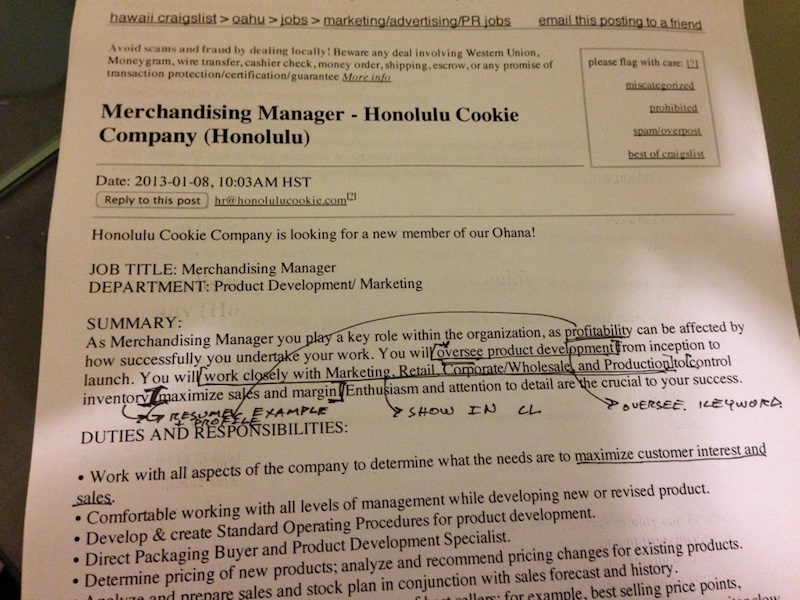
This position is very focused on profitability. Check out the keywords we can see in the summary: ‘Profitability’, ‘product development’, ‘control inventory’, ‘maximize sales and margin.’ Each of these words and phrases is something we want to highlight in our cover letter and our resume.
In my annotated copy, you can see I connected some of the underlined topics to larger ideas and next steps: ‘Resume Example’, ‘Show in Cover Letter’, and noted that ‘oversee’ is a keyword that I’ll want to use when writing the resume and cover letter.
Duties and responsibilities
I tackle duties and responsibilities in two separate ways. First, I read through my printout of the position description. I underline all keywords that pop out to me. I make note note of any positions I feel that I want to highlight in the resume and cover letter.
Now, let’s steps through this position description and highlight / underline all the words and phrases that relate to cost and revenue, project management, or specific skills that are called out for the job.

Once we do that, we can start to see the different ‘buckets’ that the duties and responsibilities fall into. Looking at this resume, it looks like they fall into four main buckets:
- Project & Product Management
- Business Analytics
- Sales Channel Management
- Marketing / Promotion Cross-Department Communication
These buckets are just groupings of the different duties on the resume. I find that thinking about them in ‘chunks’ or buckets’ makes it easier to decide what type of experience to highlight on the resume or cover letter. When writing my resume and cover letter, I’ll make sure each position (resume), experience (resume), and paragraph (cover letter) relates to at least one of these buckets. If I can, I’ll reuse the exact phrase and wording they used.
I copy the duties and responsibilities from the position description into a word editor (Word, Pages, Google Docs, etc). I break the duties and responsibilities apart so each individual sentence is on its own line.
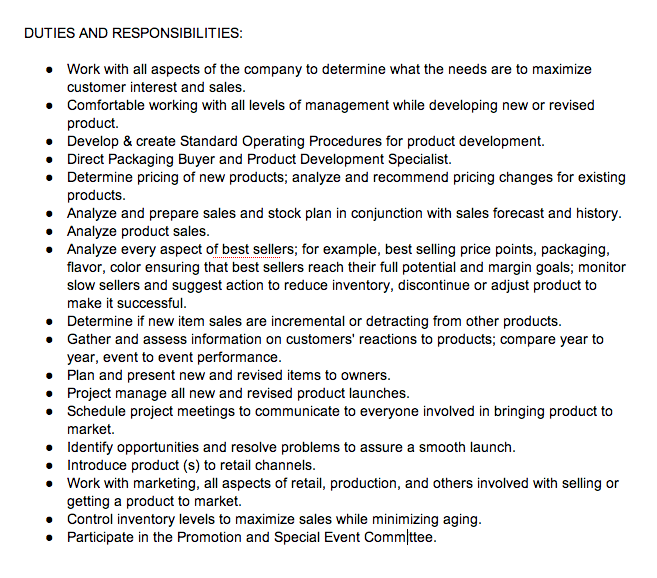
I add the buckets to the top of the page.

I start sorting the different duty and responsibility sentences into the buckets. If a duty or responsibility seems to belong in two separate buckets, I’ll copy it and put it into both buckets.
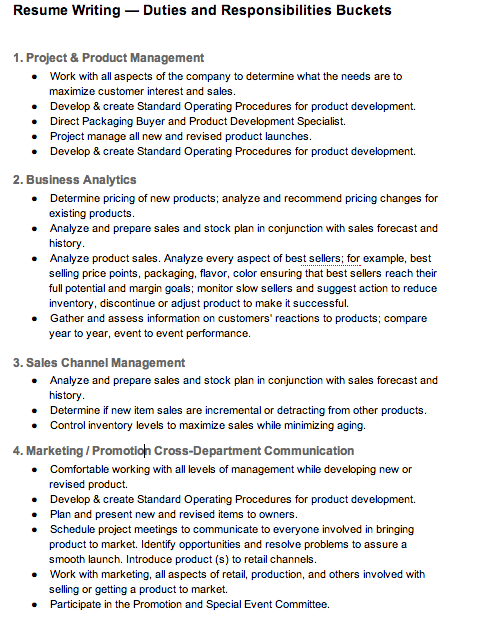
Now that we have a summary of the different areas of responsibility that relate to the position (the buckets and their contents), we have an idea of the topics we should highlight in the resume and cover letter.
Reviewing Skills
The last section in this position description is ‘Skills.’ We’ll approach it in the same way we approached ‘Duties and Responsibilities.’ On the paper copy of this position description, review the skills section. Underline / highlight any keywords that stand out. Make note any qualifications or experience that comes to mind that you want to highlight.
Once we’ve underlined this section, we’re going to add it to a new page in the document we started. The key phrases we can find in this section are highly relevant: they’re the specific skills the employer is looking for and key phrases we can reuse in our resume / cover letter / email / etc. Reusing these key phrases shows that we:
- understand the employer’s needs and also
- understand the specific language they use to communicate those needs

Okay, that’s the system I use to:
- Review position descriptions
- Identify the pain points a company is screaming in the position description
- Analyze position descriptions to pull out the company’s needs and identify the specific keywords and key phrases I should be highlighting in my resume and cover letter
Deconstructing the perfect resume (and my resume writing template)
Once you’ve broken down the job description to identify the pain points the company is experiencing and you’ve identified specific keywords and key phrases to highlight in your resume, it’s time to jump into writing the actual resume.
Every resume I write, I work off of a standard template that I store in Google Docs. Here’s a link to my resume template. Go ahead and download it (File → Download As) for the next time you need to write a resume.
There’s 5 main sections to my template, let’s step through them.
Who are you? (The Header)

The header on the resume is all about you. It’s where you put your name and any contact information you want to include. As a bare minimum, include:
- Your name
- Your phone number
- Your street address
- Your email address
- Optional: include a link to your online portfolio / gallery / personal website / writing samples. I always included a link to this site.
If I was sending out my resume right now, I’d include a link to kaisdavis.com/resume and write a custom page for that resume, talking about who I was and linking to information I’d want them to have.
If I was feeling spicy, I’d do that, but for every company I was applying to: kaisdavis.com/company-a, kaisdavis.com/company-b.
I do this tactic with Look Shiny, my marketing consulting company. When I send a follow up email to a prospect after meeting them, I’ll link them to lookshiny.com/prospect-name-here. I’ve gotten very positive feedback that putting together a page speaking specifically to the prospect and including relevant information about projects I’ve worked on has been a great way to jumpstart the relationship.
This is what the header of my resume looks like:

Professional Profile (Defining your career)
I’ll be honest with you, I cut the professional profile from resumes I write 50% of the time. Often, professional profiles are empty, meaningless wastes of space that just clutter up top of your resume.
On the plus side, they’re a quick way to define who you are and include the buzzwords you identified when you deconstructed the position statement.
Here’s what the professional profile on my resume looks like:

Lead off with your current (or highest ranking) title. Don’t make up a title or embellish your current title. If you’ve had the title at a company on a business card or in a director, list it here.
If you’re applying to a position with a ‘lower’ title (Director → Product Manager), that might set off a red flag in the mind of whoever is reading your resume. If you’re applying ‘down’ the ladder, try to match up the title you use with the title you’re applying for.
Try to include 3+ of the keywords / key phrases you identified in the position statement in the professional profile. Whenever possible, repeat the position statement’s language back in your resume. If they mentioned work closely with Marketing, Retail, Corporate/Wholesale, and Production to control inventory, maximize sales and margin, repeat that language back to them. Here’s an example:
Marketing Director with a proven ability to work closely with Marketing, Retail, Corporate/Wholesale, and Production to control inventory, maximize sales and margins.
Boom, we start off the resume immediately addressing one of their pain points and showing we have relevant experience with something they need help with. For a quick trick, that sells.
Core Competencies (Skills & Keywords)
The Core Competencies section is a place to highlight additional keywords and key phrases that you found in the position statement and want to include in your resume.
Make sure you’re only listing key phrases that are relevant to the position. You might have a long career behind you of negotiation and mediation, but if you’re applying for a position that doesn’t require those skills, don’t highlight them at the start of the resume. Only include what’s relevant and addresses the employer’s pain points.
Here’s what my Core Competencies section looks like:

Work Experience / Previous Positions
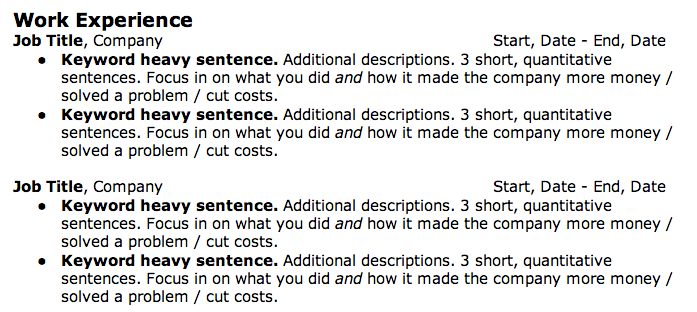
You only want to show your 3–4 most recent positions over the past 5 years. Your resume should be under 2 pages, so don’t get carried away listing everything you’ve done. Remember, it’s better to have it be short and specific to the position you’re applying for than long and full of irrelevant information.
Lead off the position with your past job title and the name of the company. List the start date and end date for that position. If you’re currently at the company, put ‘present’ for the end date.
Have two experience sections for each position with 3–4 short, quantitative sentence for each bullet point. By ‘quantitative’ I mean share whatever specific numbers you can. Compare these two sentences:
- Wrote articles and increased blog readership`
- Wrote three 500 word articles/week and increased monthly blog readership by 75% over three months.
The second example includes specific, quantitative experience for that position. That sticks out in an employer’s mind and shows you know your stuff. Whenever possible, include quantitative experience.
Each of the bullets in the job experience should connect to either one of the position ‘buckets’ or one of the specific job duties / skills / responsibilities you identified during the position description analysis.
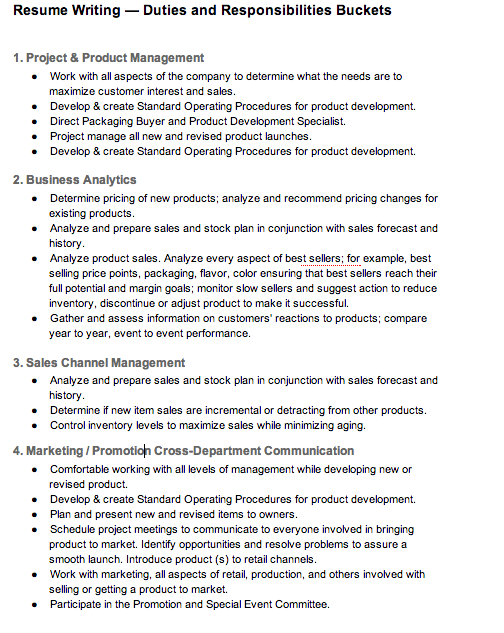
You want two bullets per job. Try and have each bullet be from a different bucket. If you can’t, don’t stress, but it’s better to show a diversity of experience in past positions. I’ll talk more about this in Part 4.
‘Work Experience’ vs ‘Other Experience’
Sometimes you’ll have a perfect position to list, but it doesn’t fit in the timeline on your resume, or it was a volunteer position.
Here’s what to do: split your experience section into Work Experience and Other Experience. This is a great way to include other relevant positions that won’t fit into the Work Experience section or aren’t traditional work experiences.
Visually, here’s what that will look like:
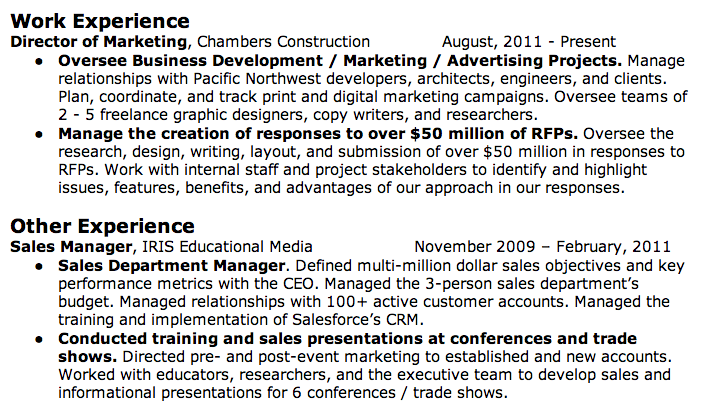
Education

List your relevant higher education experience. Don’t list your GPA. Don’t list any awards, honors, or scholarships.
How many times have I had an employer ask what my GPA is? 0. It’s pointless to include your GPA, so don’t include it.
Writing the perfect resume
Now we’ll tackle the process I use to brainstorm and write content for my resume. So far we’ve learned how to:
- Identify the major pain points an employer is experiencing that motivated them to hire a new employee
- Break down and extract the specific keywords and key phrases the employer used in the job description so we can ‘seed’ them into our resume and cover letter
- Use my resume writing template
The missing piece of this puzzle is our personal experience. What can we show our employer that demonstrates how capable we are? More so, how can we easily extract this information from our personal history?
The first step is just doing a brain dump of positions you’ve worked at. We aren’t as concerned with the specifics of your experience at this step, just cranking out a list of places that might be relevant to the position you’re applying for.
Work Experience — What We Got Paid To Do
Here’s what to do. Take out a blank piece of 8.5” x 11” paper. Down the left side of the paper, write down the 5 most recent work positions you’ve had. These can be paid positions with companies, volunteer organizations, community organizations, businesses you started yourself, etc. Anything where someone else trusted you with time, money, authority, etc.
Use a very wide and loose filter for this step. Here are a few examples of experience that my friends have realized they could include when they went through this brainstorming:
- Community youth pastor
- Small business walking dogs
- Babysitting business they worked at during college
- Managing a friend’s band (booking gigs, collecting money, managing promotion)
Be wide and loose during this step. We want to brainstorm recent positions you’ve had. Later we’ll see if they fit with the job.
Here’s what this will look like:

Volunteer Experience / Other Things You’ve Done
Take another sheet of paper and go through the same process, but with hobbies, volunteer gigs, organizations you’ve been associated with, etc.
What have your non-career experiences been like? What sort of organizations have you worked with, but maybe not been paid to work with? What activities have you been involved with?
The 1–2–3 resume writing process
When we’re writing out the resume, we want to make it feel like we’re talking to the person reading the resume. Have you ever read a resume and it reads like a list of ingredients in a recipe? Bland, uninspired, and clinical. It’s Boring.
Successful resumes speak directly to the person reading the resume. You want your resume to offer examples of specific, quantifiable, engaging experiences you’ve had at past positions that engage the person reading it.
Think about it like you’re single, at a party, and someone really cute asked ‘So, what’s your job like?’ You’d give them an interesting answer that draws them in and makes them want to ask more questions. Do that here.
“Kai, that sounds hard. Why go through the trouble?”
Because everyone else is writing in the same low-effort resume. If you put in just 10% more effort — brainstorming your experiences, tightening up your descriptions, making it relevant to the position you’re applying for — your resume will stand out compared to everyone else. 10% more effort can get you 100x more results.
Here’s how I break down the different classes of job descriptions:
| Personality | How You Describe Your Job | What They Think |
|---|---|---|
| Slacker | Worked in the sales department | Answered phones |
| Professional | Managed inventory for the sales department | Had some responsibilities |
| Executive | Managed inventory for a 6-person sales team. Coordinated bi-weekly orders and worked with customers on special orders. | Important. I should hire them fast. |
The kicker? These can all describe the same position: working as an assistant on the sales team. It all depends on how you truthfully describe the work you did.
It’s easy to spit out a short ‘slacker’ description for any position, but those sort of descriptions don’t say anything interesting or novel about your position: How did you grow? What challenges did you face? How did you save the day? Why was it interesting? What did you learn?
It takes a bit of effort to upgrade a description from slacker to professional or executive, but it’s easier than you think. With a few minutes of work brainstorming, you can pull together the specific quantifiable experience that turns any statement of experience into a great statement of experience.
#1: Brainstorm specific, quantifiable experience
Take a pen and start brainstorming the list of your responsibilities for each position. What did you work on? What projects did you touch? What were your responsibilities?
Think about what an average day was like in the position. Did you work on profit generating projects or cost cutting projects? Did you oversee anyone?
Open up a new word document and type out a 3–5 sentence description of the position. Write down keywords, key phrases, and any short notes that come to mind.
When I’m working with a client on a resume, we spend ~5 minutes per position with them walking me through an average day and me asking them who they worked with and what their responsibilities were like. We work together on a position until we push through to specific, quantifiable, and relevant experience that we can share on the resume.
Focus on identifying anything that’s quantifiable or shows how you helped the company improve. Here’s a few examples:
- The size of the team you worked with
- Amount of sales/profit generated or cash handled
- Number of customers you worked with / accounts you managed
- Number of projects you touched or were accountable for
- Team members you managed / oversaw
If you can attach a number to it, write it down.
When I’m writing my resume, I use the Rubber Duck Resume Writing process (reading the resume out loud, asking ‘What do you mean?’ for each statement) to probe deeper into my experience and identify the specifics of what I did. I want to figure out how my position either helped make the company more money or helped saved the company money.
#2: Sorting your experience into ‘buckets’
We want to sort the experiences we brainstormed into different ‘buckets’. Open up a new document and type in the keywords and experiences you’ve brainstormed. Move like experiences next to each other — sales experiences next to other sales experiences and marketing experiences next to other marketing experiences.
Add a header to the section that describes the common theme for that ‘bucket’. Here’s what an example could look like:
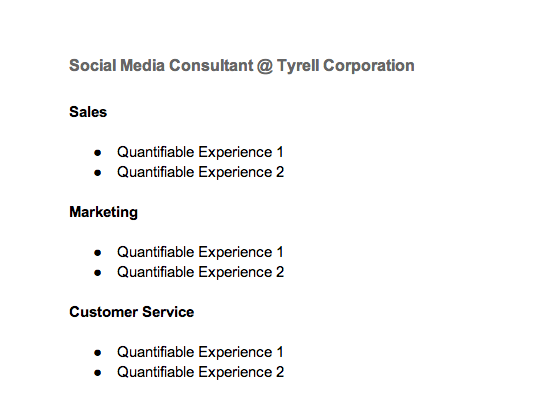
The bolded sections are the ‘buckets’, based on the keywords we brainstormed for each position. The (•) bulleted sections are the quantifiable experiences we brainstormed in the above section.
This exercise let’s us see how the different experiences we had at one company relate to each other. Do a lot of the experiences fall into one bucket? Okay, cool that’s a good thing to see. Does looking at this list make you remember any other experiences / projects at that company?
Try and make each bullet have some quantifiable element to it — something that sticks out as measurable.
Repeat this for each company you brainstormed onto the list. At the end of the exercise, you should have a document with ~6 positions and each position having multiple ‘skill’ buckets with experiences in each bucket.
#3: Reviewing the language of the position description
Go back to the brainstorming you did for the position description and look at the different buckets and skills you pulled out of the position description. Here’s what we ended up with in our example:
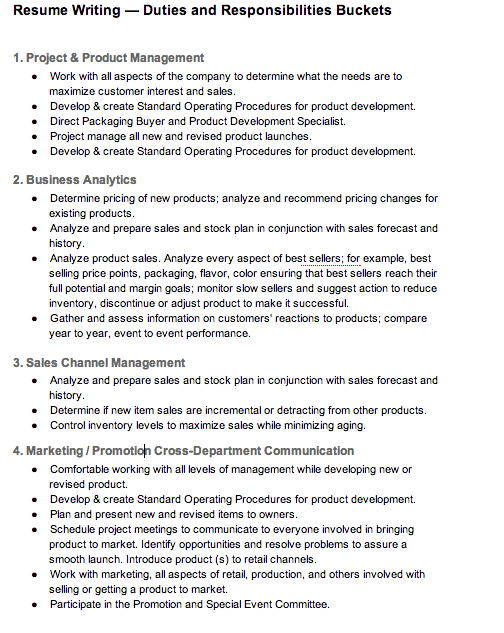
Look at the different ‘buckets’ you found in the position description. Do any match up with the buckets you identified in your job experience? Are any close?
Look at the specific duties and responsibilities in the position description. Are there any overlaps with what you listed?
When there’s a lot of overlap in ‘buckets’ or skills and responsibilities, that’s a sign that your past job should be listed on your resume when you apply to this position.
Tying it all together
The final step is to take the resume writing template and start filing in your experience. For each position on your resume, have there be ~2 buckets of experience that match up with the position description. Put ~2–4 short, quantifiable sentences into each bucket.
Whenever possible, reuse the exact language the position description used to describe the duties and responsibilities of the position. You don’t want to make the person reading your resume pause and think ‘huh, does this relate to what I asked for?’ That’s how you get your resume tossed into the trash.
Taking credit for your accomplishments & defeating ‘Martyr Syndrome’
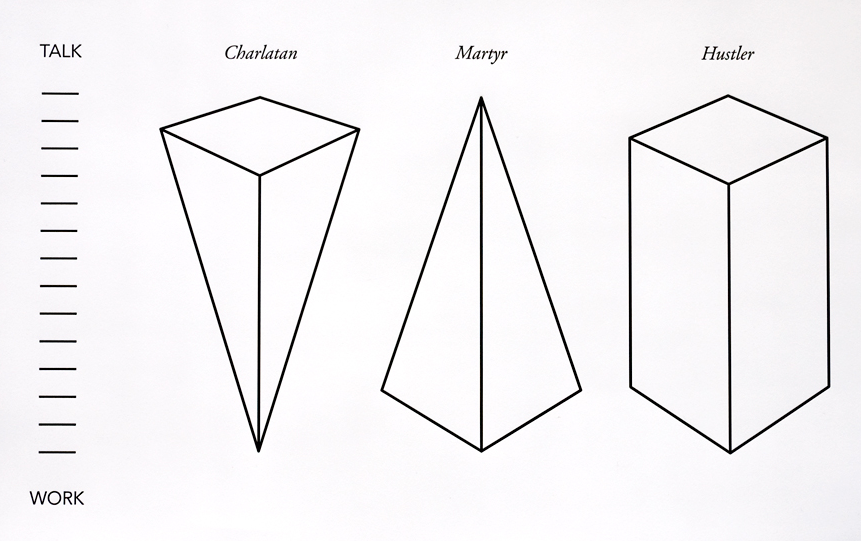 </p>
</p>
A martyr is all action with plenty of good work to talk about, but remains unable or unwilling to do the talking. — Chris Guillebeau
Can you think of a friend who puts in work on projects, but isn’t willing to take credit for the results? A friend who stays late in the office, but always promotes the accomplishments of the team over the work they put in?
| Personality Type | How They Describe Their Job |
|---|---|
| The Martyr | Worked as part of the sales team. Contributed to projects that increased revenue by 75% by initiating direct calls to prospects. |
| The Hustler | Initiated direct calls to prospects, increasing department revenue by 75%. |
When confronted with the opportunity to talk about their accomplishments and experience, The Martyr splits the credit up to the entire team. They’re afraid that they’ll get in trouble if they don’t spread the credit over the entire team.
The Hustler understands that their response depends on the context of the situation. If they’re talking with someone at a networking event or in an interview, they’ll put their best foot forward and take credit for the work they did. And they’ll have the experience to back up their statement.
When I work with someone on a résumé, I’ll ask them ‘How willing are you to take credit for your work?’ Often their answer is ‘I’m very willing, but I want to acknowledge the work that the team did.’
They don’t want to exaggerate, stretch the truth, or take ‘too much’ credit for the project. That’s a compassionate and human thought to have, but it also what the martyr thinks. It’s what keeps you from getting a job.
Employers want team players — people who put ego aside and work towards a goal that benefits the company. But employers also want people who aren’t afraid to own their accomplishments. When you write a resume or cover letter, interview for a position, or attend a networking event to meet leads for a new job, you have to be willing to put your best foot forward and own your hard work.
The projects that make up the sum of your work experience wouldn’t have happened in the same way if you weren’t a part of the team. Ergo, it’s unfair to say that the projects were due to the hard work of the team, and not your work.
I’m not saying ‘lie’ or ‘take credit for other people’s work.’ I’m saying own the hard work you put in on a project when it’s appropriate to do so: in a resume or cover letter, during a job interview, when someone asks ‘So, what do you do?’ at a party or networking event, or during your annual review.
You need to be willing to say “I worked on this project and the results were incredible. My contribution of XYZ had a direct, measurable effect on the results.” If you aren’t willing to take credit for the work you’ve done, you will never get the job you want.
You are an incredible person. If you weren’t part of that project, the accomplishments wouldn’t have been the same. Ergo, you are directly responsible for that accomplishment. So don’t be afraid to say it.
Own your hard work. Own the results you’ve created. Own the benefits you’ve brought to every company you’ve worked for. And don’t be afraid to talk about them.
A hustler represents the ideal combination: work and talk fused together. — Chris Guillebeau
Learn more What do you need to know before you apply for a job?

